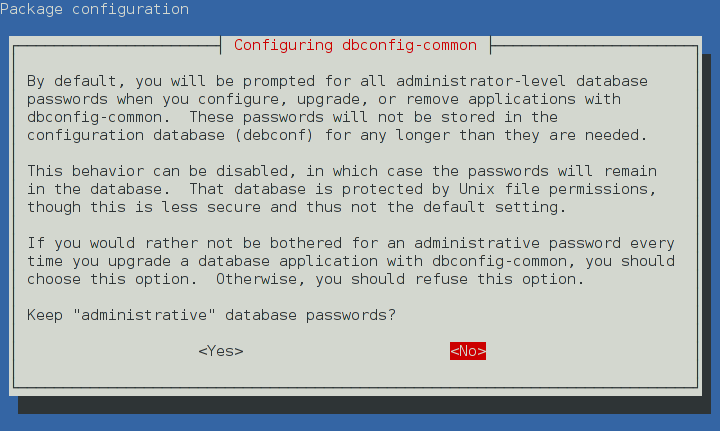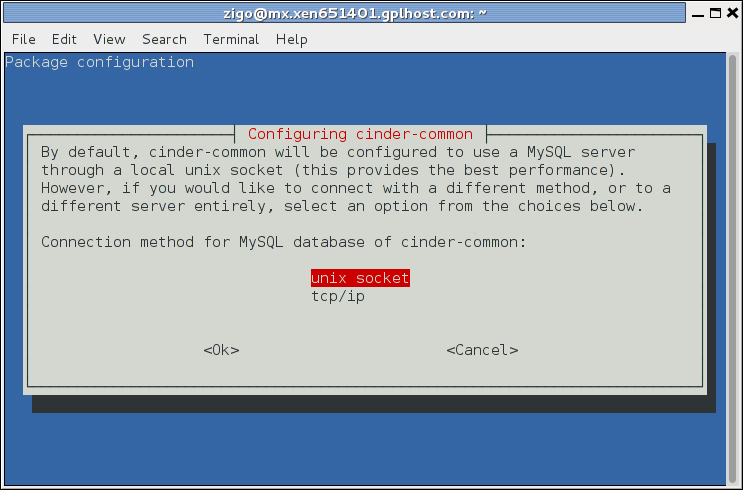As discussed in the Liberty Design Summit "Moving apps to Python 3" cross-project workshop, the way forward in the near future is to switch to the pure-python PyMySQL library as a default. https://etherpad.openstack.org/p/liberty-cross-project-python3 This change only updates the Install Guide. Change-Id: I71ff1841af54f5db870e836bc1c62499096a712e
5.4 KiB
- orphan
Configure the database with dbconfig-common
Many of the OpenStack services need to be configured to access a database. These are configured through a DSN (Database Source Name) directive as follows:
[database]
connection = mysql+pymysql://keystone:0dec658e3f14a7d@localhost/keystonedbThis connection directive will be handled by the
dbconfig-common package, which provides a standard Debian
interface. It enables you to configure Debian database parameters. It
includes localized prompts for many languages and it supports the
following database backends: SQLite, MySQL, and PostgreSQL.
By default, the dbconfig-common package configures the
OpenStack services to use SQLite. So if you use debconf in
non-interactive mode and without pre-seeding, the OpenStack services
that you install will use SQLite.
By default, dbconfig-common does not provide access to
database servers over a network. If you want the
dbconfig-common package to prompt for remote database
servers that are accessed over a network and not through a UNIX socket
file, reconfigure it, as follows:
# apt-get install dbconfig-common && dpkg-reconfigure dbconfig-commonThese screens appear when you re-configure the
dbconfig-common package:
Unlike other debconf prompts, you cannot pre-seed the responses for
the dbconfig-common prompts by using
debconf-set-selections. Instead, you must create a file in
/etc/dbconfig-common.
For example, you might create a keystone configuration file for
dbconfig-common that is located in /etc/dbconfig-common/keystone.conf, as follows:
dbc_install='true'
dbc_upgrade='true'
dbc_remove=''
dbc_dbtype='mysql'
dbc_dbuser='keystone'
dbc_dbpass='PASSWORD'
dbc_dbserver=''
dbc_dbport=''
dbc_dbname='keystonedb'
dbc_dbadmin='root'
dbc_basepath=''
dbc_ssl=''
dbc_authmethod_admin=''
dbc_authmethod_user=''After you create this file, run this command:
# apt-get install keystoneThe Identity service is installed with MySQL as the database back
end, keystonedb as database name, and the localhost socket
file. The corresponding DNS will then be:
[database]
connection = mysql+pymysql://keystone:PASSWORD@localhost/keystonedbThe dbconfig-common package will configure MySQL for
these access rights, and create the database for you. Since OpenStack
2014.1.1, all OpenStack packages in Debian are performing the following
MySQL query after database creation (if you decide to use MySQL as a
back-end):
ALTER DATABASE keystone CHARACTER SET utf8 COLLATE utf8_unicode_ciSo, if using Debian, you wont need to care about database creation, access rights and character sets. All that is handled for you by the packages.
As an example, here are screenshots from the
cinder-common package:
By default in Debian, you can access the MySQL server from either
localhost through the socket file or 127.0.0.1. To access it over the
network, you must edit the /etc/mysql/my.cnf file, and the
mysql.user table. To do so, Debian provides a helper script
in the openstack-deploy package. To use it, install the
package:
# apt-get install openstack-deployand run the helper script:
# /usr/share/openstack-deploy/mysql-remote-rootAlternatively, if you do not want to install this package, run this script to enable remote root access:
#!/bin/sh
set -e
SQL="mysql --defaults-file=/etc/mysql/debian.cnf -Dmysql -e"
ROOT_PASS=`${SQL} "SELECT Password FROM user WHERE User='root' LIMIT 1;" \
| tail -n 1`
${SQL} "REPLACE INTO user SET host='%', user='root',\
password='${ROOT_PASS}', Select_priv='Y', Insert_priv='Y',\
Update_priv='Y', Delete_priv='Y', Create_priv='Y', Drop_priv='Y',\
Reload_priv='Y', Shutdown_priv='Y', Process_priv='Y', File_priv='Y',\
Grant_priv='Y', References_priv='Y', Index_priv='Y', Alter_priv='Y',\
Super_priv='Y', Show_db_priv='Y', Create_tmp_table_priv='Y',\
Lock_tables_priv='Y', Execute_priv='Y', Repl_slave_priv='Y',\
Repl_client_priv='Y', Create_view_priv='Y', Show_view_priv='Y',\
Create_routine_priv='Y', Alter_routine_priv='Y', Create_user_priv='Y',\
Event_priv='Y', Trigger_priv='Y' "
${SQL} "FLUSH PRIVILEGES"
sed -i 's|^bind-address[ \t]*=.*|bind-address = 0.0.0.0|' /etc/mysql/my.cnf
/etc/init.d/mysql restartYou must enable remote access before you install OpenStack services on multiple nodes.







